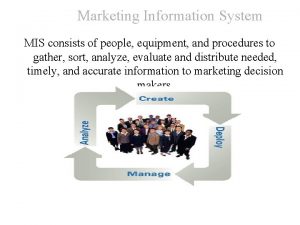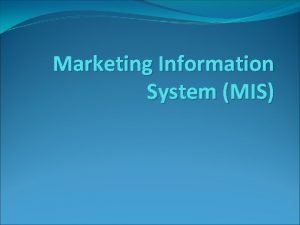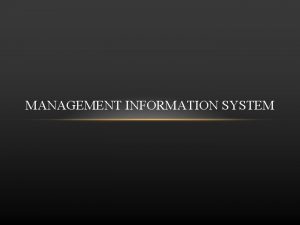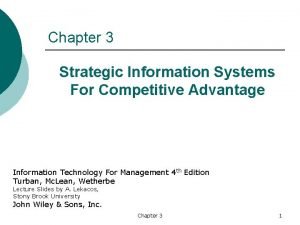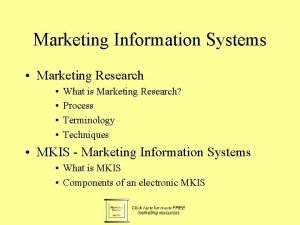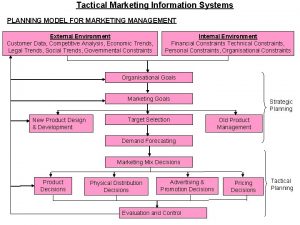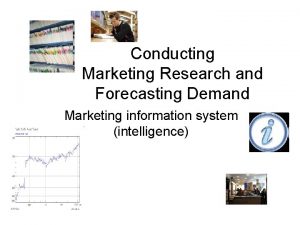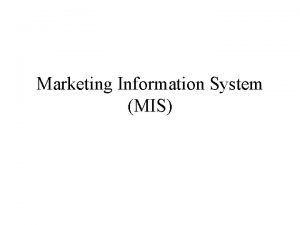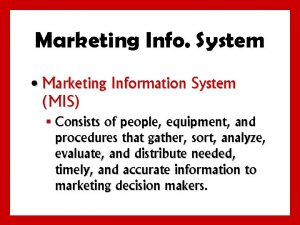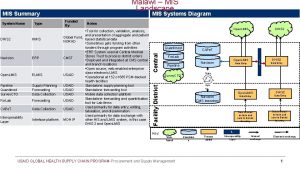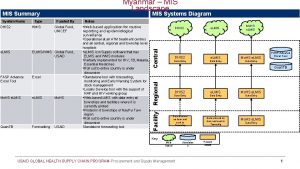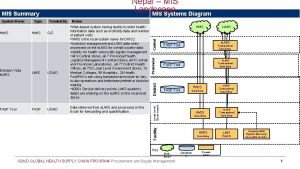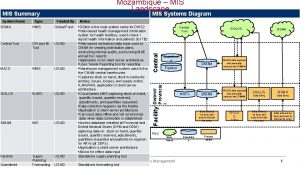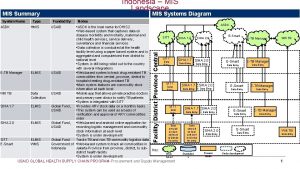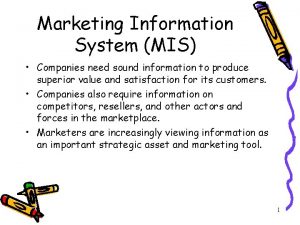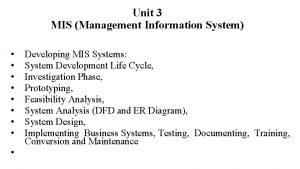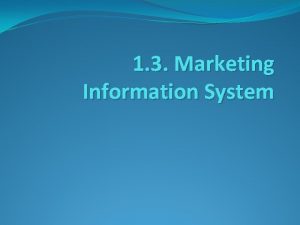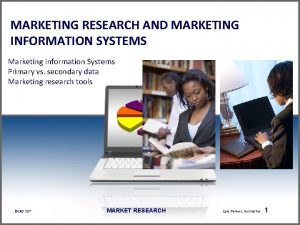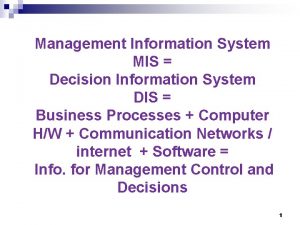Marketing Information System MIS consists of people equipment
























- Slides: 24

Marketing Information System MIS consists of people, equipment, and procedures to gather, sort, analyze, evaluate and distribute needed, timely, and accurate information to marketing decision makers.

Why Market Information is Required? – Local to National to Global Marketing – From Buyer needs to buyer wants – From price to non price competition

Assessment of Information Needs Internal MIS Committee can interview marketing managers to discover their information needs: – – – – – What decisions do you regularly make? What information do you regularly get? What information do you need to make these decisions? What special studies do you periodically request? What information would you want daily? Weekly? Monthly? Yearly? What magazines and trade reports would you like to see on a regular basis? What topics would you like to be kept informed of? What data analysis programs would you want? What are the four most help improvements that could be made in the present marketing information system?

Components of MIS Internal Records System Marketing Intelligence System Marketing Research System Marketing Decision Support System Marketing Information System

Working of Marketing Information System

Internal Records System Provide internal data on orders, sales, prices, costs, inventory levels, receivables, payables, and so on. Result Data Internal Record System Order to Payment Cycle Sales Information System Customers favor shorter cycles. Computerized Warehouses, Electronic Data Interchange allow this. Information on prospect customers, current sales etc. It can be managed through Sales Force Automation Software.

Marketing Intelligence System is a set of procedures and sources used by managers to obtain everyday information about developments in the marketing environment. Intermediaries. Purchase Happening Sales Force Information. Purchase Centres Information Competitor Product Customer Advisory Panel Sources of Information Data

3. Marketing Research System Primary Source Conduct Own Research Hire Research Firm Secondary Source Suppliers of Research System Internal Sources Government Publication Periodicals & Books Commercial Data Marketing Research is the systematic design, collection, analysis and reporting of data and findings relevant to a specific marketing situation facing the company.

Marketing Research System Syndicated Service Research Firms (Firms gather information and sell it) Custom Marketing Research Firms (Firms are hired to carry Out specific project) Specialty-line Marketing Research Firms (These provide specialty Research services) Engaging Students or Professors To design and carry out projects Conducting Research Using the Internet Checking out rivals

Marketing Research Process

Step 1: Define the Problem and Research Objectives • Exploratory: Its goal is to shed light on the real nature of the problem and to suggest possible solutions or new ideas. Descriptive: It seeks to ascertain magnitudes, relations between variables and analytical in nature. ● ● Causal: Its purpose is to test a cause and effect relationship.

Step 2: Develop the Research Plan Data Sources Contact Methods Sampling Plan Research Instrument Research Approach

(i) Data Source • Primary Data: Data gathered for a specific purpose or for a specific research project. • Secondary Data: Data that were collected for another purpose and already exist some where. • This collected data can form the backbone of later marketing campaigns. – E. g. Customer or Prospect Database (collection of comprehensive data about individual customers, prospects, or suspects) can be used for lead generation, lead qualification, sale of product or service, or maintenance of customer relationships.

(ii) Research Approaches Observational Research: – Data gathered by observing the relevant actors and settings. Focus-Group Research: § Gathering of 6 to 10 people § Spend a few hours with a skilled moderator to discuss marketing issues. Survey: § Best suited for descriptive research. § To learn about people’s knowledge, beliefs, preferences, and satisfaction. § Measure these magnitude in the general population. Behavioral Data: § Customers leave traces of their purchasing behavior in store scanning data, catalog purchase records, and customer database. Much can be learned by analyzing this data. § Customer’s actual purchases reflect their preferences. Experiments: § Most Scientifically valid research § Capture cause and effect relationships

(iii) Research Instruments (primary data) Questionnaire Consists of a set of questions presented to respondents for their answers. • Close Ended Question • Open Ended Question Mechanical Instruments E. g. Galvanometer measure the interest or emotions aroused by exposure to a specific ad or picture.

Questionnaire A. Closed-end Questions Name Description Example Dichotomous A question with two possible answers. In arranging this trip, did you personally phone American? Yes No Multiple Choice A question with three or more answers. With whom are you traveling on this flight? Likert scale A statement with which the respondent shows the amount of agreement/ disagreement. No one Children only Spouse Business associates/friends/relatives Spouse and children An organized tour group Small airlines generally give better service than large ones. Strongly Disagree Neither agree Agree Strongly disagree nor disagree 1_____ 2 _____ 3_____ 4_____ 5_____

(iv) Sampling Plan • Sampling Unit: Who is to be surveyed? • Sample Size: How many people should be surveyed? • Sampling Procedure: How should the respondents be chosen? – Probability Sampling / Random Sampling – Non-probability Sampling

(v) Contact Methods Mail Questionnaire ● Telephone Interview ● Personal Interview ● Intercept Interview ● On-line Interview ●

Marketing Research Process • Step 3: Collect the Information • Step 4: Analyze the Information • Step 5: Present the Finding

Characteristics of Good Marketing Research • • • Scientific Method Research Creativity Multiple methods Value and cost of Information Ethical Marketing

Barriers to Marketing Research Narrow Conception of Marketing Research Uneven caliber of Marketing researchers Problems Personality and Presentational differences Late and Occasionally Erroneous Findings by marketing research

Marketing Decision Support System (MDSS) is a coordinated collection of data, system, tools and techniques with supporting software and hardware by which an organization gathers and interprets relevant information from business and environment and turns it into a basis for marketing action.

Summary ØIn today’s competitive environment the organizations can not survive without information. ØAnd so marketing information system evolved to collect, store, organize, interpret and utilize the required information for various purposes. ØIt involve people, equipments, procedures, hardware and software. ØIn MIS we collect information from internal sales record, external parties and through marketing research. ØThrough marketing research we can find out the information desired from the market by using different tools and techniques. ØAll data gathered from various resources is analyzed and interpreted to take decisions. ØMarketing decision support system help in taking intelligent decisions by using the gathered data, statistical tools and other techniques ØThese decision are used by marketing manager to make new strategies for the products and organization.

 Characteristics of marketing information system
Characteristics of marketing information system A marketing information system mis consists of
A marketing information system mis consists of Mis meaning
Mis meaning Marketing information system and marketing research
Marketing information system and marketing research Mis information system
Mis information system Advantages of strategic information system
Advantages of strategic information system Mis principios en un proyecto de vida
Mis principios en un proyecto de vida Son los padres de mis tios
Son los padres de mis tios Mis mai a mis tachwedd
Mis mai a mis tachwedd Mis mai a mis tachwedd
Mis mai a mis tachwedd Cuales son mis creencias
Cuales son mis creencias Finer segmentation strategy
Finer segmentation strategy Marketing information systems and marketing research
Marketing information systems and marketing research Marketing information systems and marketing research
Marketing information systems and marketing research Marketing information system kotler
Marketing information system kotler Marketing information systems and marketing research
Marketing information systems and marketing research Marketing is the performance of business activities
Marketing is the performance of business activities Define marketing environment
Define marketing environment Tactical information systems
Tactical information systems Marketing information system kotler
Marketing information system kotler Capturing marketing insights
Capturing marketing insights Benefits of secondary research
Benefits of secondary research Recruise meaning
Recruise meaning Analytical marketing system
Analytical marketing system Collecting information and forecasting demand summary
Collecting information and forecasting demand summary
